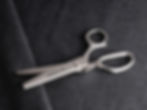What Are Pinking Shears?
- WAWAK Sewing Supplies
- May 9
- 4 min read
Updated: Jun 6
Have you ever used a pair of zigzag scissors for a crafting project? Pinking shears might be more familiar than you think! These saw-toothed sewing scissors cut fabrics and sewing materials with a zigzag edge. They're not just for decoration, though—pinking shears also serve a functional purpose in sewing: reducing fraying for woven materials. Looking for a high-quality pair of pinking shears for your projects? Find them at WAWAK.

WHAT ARE PINKING SHEARS?
Pinking shears are a style of sewing scissors that feature saw-toothed blades to make zigzag cuts. They're primarily used to finish the edges of woven fabrics and prevent the raw edges from fraying. Like other styles of sewing scissors, pinking shears come in different lengths and sizes for different fabric weights. Pinking shears are best used for woven fabrics or non-woven materials; avoid cutting knit materials with pinking shears, as they typically do not cut cleanly through knit fabrics.
What Are Pinking Shears Used For?
Reduce Fraying & Prevent Unraveling
In sewing, the most common use for pinking shears is to reduce fraying and prevent unraveling when working with woven fabrics. Woven fabrics can be very prone to fraying when cut on a straight edge, and pinking shears help keep the fray at bay! Pinking shears work by limiting the length of fraying threads. This means any fraying that does occur produces short segments of thread that easily shed off, instead of long fraying threads that can continue unraveling and tangling up the length of the fabric.
Pinking shears don't guarantee that your fabrics won't fray, especially if they have a looser weave or are frequently washed in a washing machine—but they do offer a quick, easy way to reduce fraying on tightly-woven fabrics. They're often used to finish seams inside garments, cut quilt squares or fabric swatches, and even finish raw fabric edges without sewing on some materials. Need to pre-wash your woven fabric before sewing? Try pinking the edges first to help prevent a tangled mess from coming out of the washing machine.
QUICK TIP: PINKING SHEARS WORK BEST ON TIGHTLY WOVEN MATERIALS. THE LOOSER THE FABRIC WEAVE, THE MORE PRONE IT IS TO FRAYING, EVEN WITH A PINKED EDGE.
Reduce Bulk
Another common use for pinking shears is to remove material from bulky seams. Cutting away or grading seam allowances with pinking shears allows you to neatly remove excess fabric to prevent a seam from becoming too thick. Similarly, pinking shears are sometimes used to notch and clip curved seams for a smoother curve or "soften" the edges of interfacing materials to help them lie flat.
Create Decorative Edges
Lastly, pinking shears can, of course, be used to create a decorative zigzag edge! This is an excellent option for materials that don't fray, like felt, leather, or vinyl. They can be used for applique, crafts, décor, bag making, accents, and any other designs you might dream up.

Frequently Asked Questions About Pinking Shears
Can You Sharpen Pinking Shears?
Yes, it's possible to sharpen pinking shears! However, it's most likely something you'll want to leave to a professional. Unless you're an experienced scissor sharpener, pinking shears are probably too tricky to successfully sharpen on your own due to their irregular edges. A professional sharpening service, however, (especially one that specializes in scissors) should have no trouble getting dull pinking shears sharp again!
You might have heard of at-home tricks for sharpening scissors like cutting through aluminum foil or sandpaper, but these are not recommended. While these methods could give the impression of improved sharpness by buffing out small burrs or cleaning the blades, they do not actually sharpen the blade edges and could even cause them to dull further. When it comes to sharpening pinking shears, a professional sharpening service is your best bet!
Do Pinking Shears Stop Fraying?
Pinking shears do not completely stop fraying, but can reduce the amount of fraying and prevent unraveling. The zigzag cut helps make materials less prone to fraying and shortens the length of the threads that do fray, preventing excessive unraveling and fabric damage. Loosely-woven fabrics are also more likely to fray, even with a pinked edge.
Why Are They Called Pinking Shears?
The exact origin of the term "pinking" isn't definitively known. One popular theory is that it comes from common garden flowers of the Dianthus family, commonly known as "pinks," which have a scalloped or jagged edge on their petals.
What Is An Alternative To Pinking Shears?
There are plenty of alternate techniques to finish a raw fabric edge without pinking shears: sealing it with fray check, using a zigzag stitch or overcast stitch, binding the edges with bias tape, and serging, just to name a few! But if you want to stick with pinked edges without using pinking shears, you can opt for a rotary pinking blade for your rotary cutter instead. If you expereince hand fatigue with standard pinking shears, we also offer Easy Action Pinking Shears, which spring open after each cut for easier cutting.





